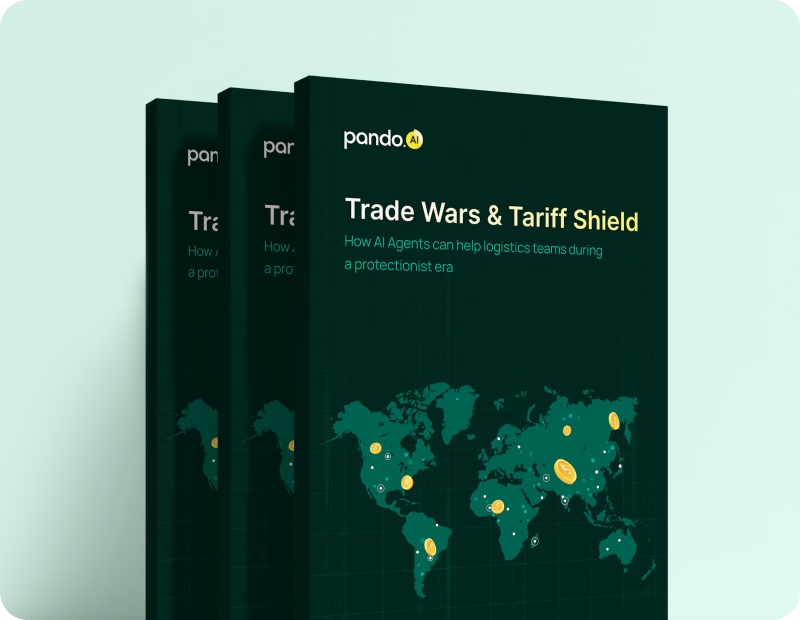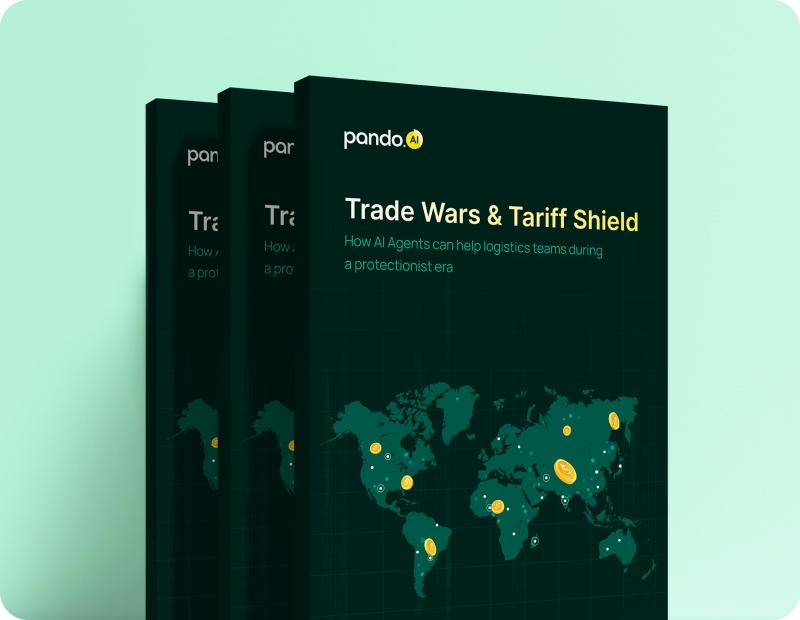-
Products Products
- Industry
- Initiatives
- Resources
- Company
- Book a demo

Before you go: Logistics leaders just dropped the truth on AI
The State of AI in Logistics 2025 is here — no hype, just real conversations and raw insights.
Learn why freight optimization can help your organization drive optimization across the board— from procure to pay
As a shipper, optimizing freight operations is the lynchpin between keeping the bottom line secure and improving customer experience. While a definitive figure can be elusive, the annual State of Logistics Report indicates that US enterprises spent 4-5% of their revenue on freight transport. Roughly translating to $1 trillion, that number offers a lot of scope for businesses to work towards austerity. With retail consumption picking up after the pandemic years and with domestic inflation reaching record highs, there is an incentive for businesses to take stock of all aspects of their logistics and optimize across the board of operations. A TMS (Transportation Management System) enables this by maintaining freight contracts for regularly plied lanes and providing visibility across lanes. However, this does not guarantee savings. Investing in best practices around freight optimization leveraging your TMS solution is the key to driving optimization across the board— from procure to pay logistics operations.
Here’s how a TMS helps achieve freight optimization across your processes: 
Freight sourcing
1. Optimal vendor allocation for each lane
Finding the right carrier for each route (lane) is crucial for freight optimization. For industries such as automotive, awarding lanes to competitive vendors takes precedence due to the value of the materials involved. However, for other industries such as pharma, there are compliances and safety regulations involved when executing shipments. Optimal lane vendor allocation helps you match these shipment needs with carriers that offer the best capacity and service requirements for each lane.
A TMS optimization tool helps you analyze past data to identify the best allocation strategies to ensure maximum coverage for all lanes. You can automate bid requests, match lanes with suitable vendors based on your priorities, and provide real-time visibility to allow for alternatives if needed. Furthermore, TMS helps you manage contracts and track carrier performance, ensuring you get the most out of your lane allocations. By leveraging these capabilities, companies can significantly improve their overall freight optimization and achieve a more efficient supply chain.
2. Diversified carrier networks for better cost and customer experience
When it comes to freight optimization, relying on a limited pool of carriers can hinder efforts toward transportation optimization. By diversifying your carrier network, you gain several advantages. First, you have options to compare rates and choose the most cost-effective option for each shipment. Second, a wider network helps you access specialized carriers that handle specific needs like speed or fragile items without compromising on cost. In industries like energy or pharma, where volumes are high but come with specific norms for transport, having a diversified carrier selection at your disposal offers flexibility. This improves service levels and reduces the risk of damage. Finally, diversification makes your supply chain more resilient. If your designated carrier faces issues or is unavailable to offer a contracted trip, having a backup helps keep your freight moving. In short, a diversified carrier network keeps your operations covered with better control and flexibility, leading to more efficient and reliable logistics operations.
3. Choosing the right mix between spot and contracted tenders
Choosing between spot rates and contracted lanes is a crucial decision for freight optimization. Spot rates are best suited for shipments that are one-off or when flexibility is required in terms of delivery. The downside is - limited options and potentially paying a premium for shipments (say less-than-full truckloads). Your TMS can help find competitive spot rates through connections to freight marketplaces. Alternately, contracted lanes offer stable pricing and guaranteed capacity for frequently used routes. These contracts, negotiated and awarded through dedicated auctions allow you to have full-fledged visibility into your pricing and make informed decisions on contracted lanes. TMS helps analyze data to recommend lanes for contracts and provides real-time visibility into spot market fluctuations. It can also optimize routes, potentially reducing the need for extra shipments and influencing contracting decisions.
With such flexibility, you can use contracted lanes for predictable, high-volume shipments and spot rates for occasional or low-volume situations where flexibility is key. This allows you to weigh options for each shipment leading to reduced transportation costs, improved efficiency, and better cost predictability, thereby translating to significant freight optimization within your transportation network.
Transportation planning
1. Consolidating orders to benefit from economies of scale
Consolidating orders plays a vital role in optimizing freight transportation. Combining smaller orders into larger shipments allows companies to benefit from cheaper bulk rates offered by carriers. This significantly reduces transportation costs per item. Additionally, fewer shipments mean fewer trucks on the road, leading to less fuel consumption and environmental impact. Furthermore, consolidated shipments enable optimized routes with fewer stops, potentially leading to faster deliveries for customers. Overall, order consolidation offers a win-win situation for businesses, the environment, and customer satisfaction.
2. Load planning for efficient utilization of capacity
Load planning is essential for optimizing freight transportation. It allows businesses to pack more cargo into each vehicle, reducing the number of trips needed. This translates to cost savings on fuel and labor, along with environmental benefits due to fewer emissions. Additionally, efficient load planning helps ensure safe transport by distributing cargo evenly within a vehicle, preventing damage and accidents.
Furthermore, load planning integrates well with route optimization. By understanding how cargo is arranged, routes can be designed for the most efficient delivery sequences. Technological advancements like 3D load planning offer even greater efficiency by analyzing data and suggesting optimal loading configurations around stacking norms, order of loading, or managing non-standardized dimensions. This helps businesses achieve their goals of reduced costs, environmental responsibility, and a smooth-running freight operation.
Transportation execution
1. Real-time tracking and visibility to track
Real-time tracking and visibility revolutionize transportation execution, giving you a constant eye on your freight. This translates to better decision-making. You can optimize routes on the fly, proactively address delays, and streamline processes at loading and unloading points. The benefits are numerous: cost reduction through optimized routes and better carrier deals, improved efficiency, and happier customers thanks to accurate delivery timelines. In short, real-time visibility empowers you to take control and optimize every step of your freight's journey.
2. Carrier performance tracking to improve productivity
Carrier tracking and visibility are game changers for freight optimization. Real-time data on shipment location and carrier performance allows companies to make smarter decisions. They can choose the most reliable carrier for the job, identify areas for cost savings, and proactively address potential delays. This translates to smoother operations, efficient resource allocation, and ultimately, on-time deliveries.
Furthermore, this level of visibility fosters better customer service. Companies can provide accurate estimated arrival times, minimize disruptions, and keep customers informed throughout the journey. This transparency builds trust and leads to a more positive customer experience. By optimizing transportation with carrier tracking, companies win on both ends - efficiency and happy customers.
3. Leveraging freight spend analytics to achieve data-driven cost savings
Freight spend analytics unlocks cost savings and efficiency gains in transportation execution. By analyzing data on your spending patterns, you can pinpoint areas where expenses are highest, like specific lanes, carriers, or shipment types. This visibility allows you to negotiate better rates with carriers, identify opportunities for shipment consolidation, and optimize routes to reduce empty miles and fuel consumption.
Equipped with these insights, Transportation Management Systems (TMS) you can automate carrier selection based on cost parameters and integrate real-time shipment tracking with your spend data. This proactive approach allows you to identify and address potential delays, minimizing disruptions and additional costs. Overall, freight spend analytics empowers data-driven decision-making to optimize your transportation execution and achieve significant cost reductions.
The emergence of artificial intelligence (AI) enabled TMS systems with no-code platforms has helped organizations realize value sooner and enjoy faster turn-around on their implementations. With decreased reliance on coding for setting up and running AI-powered freight optimization solutions, logistics teams are today empowered to configure and optimize freight movement strategies without extensive IT support. The result? Increased efficiency, cost savings, and a competitive edge in a dynamic marketplace. As AI and no-code platforms continue to evolve, we can expect even more sophisticated tools that further streamline freight optimization within the TMS, making the logistics landscape more accessible and efficient than ever before. Engaging all stakeholders throughout setting up your process can help improve adoption and drive savings across your network.
Subscribe to Pando blog and Crossroads newsletter now!
Stay up to date with the latest logistics, transportation, and supply chain tips and news.
Subscribe Here!

Related blogs
Freight management system: Transforming logistics for modern businesses














